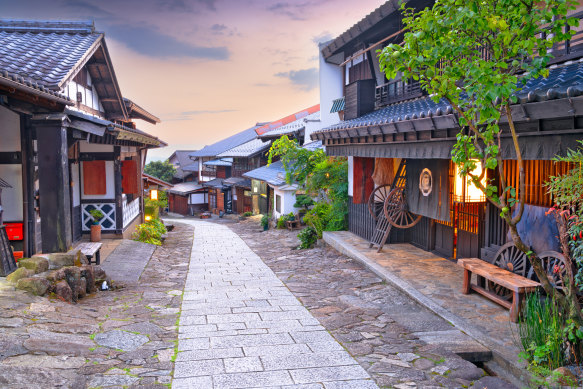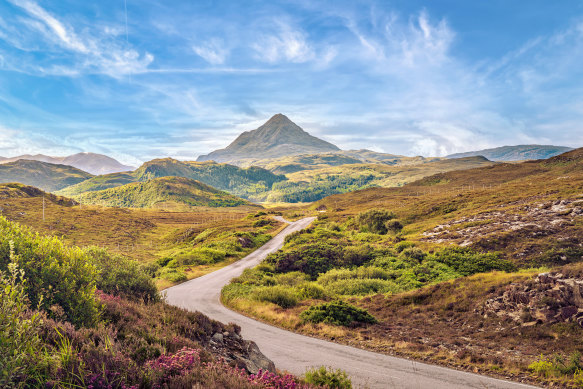Opinion
Tripologist: What places should we visit with 10 days in Japan?
Michael Gebicki is Traveller’s expert Tripologist. Each week he tackles the thorny issues in travel as well as answering your questions. Got a question for the Tripologist? Email tripologist@traveller.com.au
Michael Gebicki
The TripologistWe’re a family travelling to Japan for two weeks in October with children aged eight and 10. We are flying in and out of Tokyo and heading first to Fukuoka but what other places should we include on the way back to Tokyo over 10 days that would work for all of us?
A. Osbourne, Kingston, ACT

Magome, Japan is found along the Nakasendo Trail between Tokyo and Kyoto.Credit: iStock
You can reach Fukuoka by train in under six hours and this is a thrilling introduction to Japan’s superb high-speed train network. From Fukuoka it’s just a 70-minute train trip to Hiroshima but you need to consider whether the city’s Peace Memorial Park is an experience that your children can handle, and The Family Voyage lays out what you can expect. Your next stop might be Naoshima Island, in the Seto Inland Sea, one of the stars of the international contemporary arts scene. It’s a delight, an eye-opening experience with galleries, sculpture parks and art installations in surprising places.
Continue to Kyoto to see some of Japan’s most famous gardens and temples and then to Takayama, surrounded by the hills of the Japan Alps. There’s a superb collection of Edo-style merchants’ houses along Ojinmachi and every morning from about 7am Miyagawa Market brings colour and fragrant smells to the walking path along the river. Above the city the Higashiyama Walking Trail wanders through a dozen historic Buddhist temples with enormous bronze bells and shingled roofs.
If time allows, spend a couple of nights in Magome, one of the towns on the Nakasendo Trail, the original road between Tokyo and Kyoto, and still powerfully evocative of Japan in its cloistered Edo era. You can walk a half-day section of the Nakasendo between Tsumago and Magome, where the trail threads through mossy forests of cypress trees and rice farms, past Shinto shrines and tea houses and over galloping streams. Magome is a five-hour journey by taxi, bus and train from Tokyo. See The Man in Seat 61 website for a primer on train travel in Japan.
Together with a friend I am planning to drive the North Coast 500 in Scotland next June. Which way to go, clockwise or anti-clockwise? Places to stay? And how long should we allow?
J. Bartlett, Hawthorn, Vic

Ben Stack mountain in Scotland’s north.Credit: iStock
Anti-clockwise is the more popular choice for the North Coast 500, and one reason is this allows for a more gradual introduction to the scenic highlights of Scotland’s north, but there’s nothing to dislike about a clockwise circuit. The North Coast 500 website has several itineraries based on various themes you might like to follow, such as history, heritage and archaeology, or food and drink. The website also has accommodation suggestions.
There are also several online itineraries suggested by travellers such as Finding the Universe. While the concept of a 500-mile (804 kilometre) circuit of the top third of Scotland might stretch credibility, the route weaves out and around the long fingers that reach into the sea to become a looping, swooping 830-kilometre adventure, lavishly endowed with castles, sea stacks, sea-fretted beaches, lochs and trails once trodden by the Picts. Five days is the absolute minimum, a week is better, but nine days would be perfect for a leisurely trip, and there’s much to take in. This is a less-visited Scotland, packed with wonders. It’s heart-stoppingly beautiful.
After visiting Basel we have three days before we need to be in Rome. We’d like to take the ride up to the Jungfraujoch railway station, any suggestions?
S. Callan, Bondi, NSW
The train ride from Basel to Lauterbrunnen, the jump-off point for the Jungfrau, will take about 2½ hours. Lauterbrunnen sits deep in the valley and while it’s spectacular, I prefer to stay higher up, at Wengen, which is accessible by mountain railway from Lauterbrunnen, and which has more impressive views. From Wengen the Wengeneralp Railway takes you to Kleine Scheidegg where you change to the Jungfrau Railway which takes you to the Jungfraujoch, Europe’s highest railway station. It’s an incredible journey, bored through the innards of the mountain.
At the Eismeer viewing point at 3159 metres, the train makes a brief stop for the view from inside the fearsome north face of the Eiger, a testing ground for some of the world’s greatest mountaineers. When you leave the train you’ll step out onto ice or snow, be prepared for the cold and wear decent footwear.
From here you can ascend even higher by taking the lift to the Sphinx viewpoint at 3571 metres. At almost $400, the ride aboard the mountain railway is almost as breathtaking as the view but you can slash that with a Swiss Half Fare card which cost $200 and gives you incredible value. While you are in the area don’t miss the ride aboard the Schilthorn Cableway for incredible views over the Swiss Alps. The fastest train from Lauterbrunnen to Rome will take about 8½ hours.
My husband and I are looking for a guided tour of Mongolia that delivers an immersive exploration of the country’s steppe culture. Modest comfort is desirable but nothing like the glamping yurt camps that have sprung up.
B. Scowcroft, Northcote, Vic
Eternal Landscapes is a small, Mongolian-registered tour operator that specialises in Mongolia. Since 2010, founders Jessica Brooks and Turuu have offered small-group trips, as well as tailor-made tours with trekking, horse trekking, monasteries, wildlife and stays with the Kazakh eagle hunters of the Altai Mountains as possible themes. Their trips venture beyond conventional tourism, offering a nuanced view of Mongolian society that benefits both visitors and locals.
Eternal Landscapes has worked extensively with families living in remote areas and you can expect to share something of their lives, which are lived according to very different rhythms from your own. Food can be a challenge for travellers in remote parts of the country and each of the vehicles that Eternal Landscapes uses has a portable kitchen that offers greater variety to complement the traditional meat-based Mongolian cuisine. Prices are reasonable and reviews of Eternal Landscapes are universally outstanding.
Travel advice is general; readers should consider their personal circumstances.
Sign up for the Traveller newsletter
The latest travel news, tips and inspiration delivered to your inbox. Sign up now.